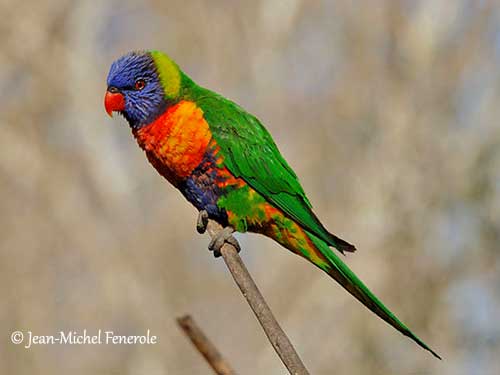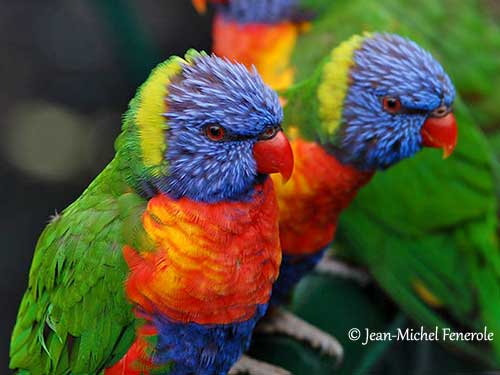
Fr: Loriquet arc-en-ciel - Loriquet de Swainson
Ang : Rainbow Lorikeet
All : Regenbogenlori
Esp : Lori Arcoiris
Ital : Lorichetto di Swainson
Nd : Lori van de Blauwe Bergen
Sd : regnbågslorikit
Photographers:
Aurélien Audevard
OUESSANT DIGISCOPING
Jean Michel Fenerole
Photos d’Oiseaux du monde
Text by Nicole Bouglouan
Sources:
HANDBOOK OF THE BIRDS OF THE WORLD volume 4 by Josep del Hoyo, Andrew Elliot and Jordi Sargatal – LYNX EDICION – ISBN 8487334229
PARROTS OF THE WORLD – An Identification Guide – by Joseph M. Forshaw – Princeton University Press – ISBN 0691092516
Wikipedia, the free encyclopaedia
Rainbow Lorikeet
Trichoglossus moluccanus
Psittaciforme Order – Psittaculidae Family
INTRODUCTION:
The Rainbow Lorikeet is one of the most striking coloured and noisy birds of all the parrot species found over SW Pacific.
This species is found in Australia where it feeds on fruit, pollen and nectar in the rainforest, in coastal bush and woodlands. It typically nests in various cavity types, in trees, hollows or even sometimes in buildings.
It is now treated as a full species with two subspecies.
The Rainbow Lorikeet is not globally threatened for the moment.
DESCRIPTION OF THE BIRD:
Biometrics:
Length: 25-30 cm
Wingspan: 46 cm
Weight: 100-157 g
The adult has bright green upperparts, wings and tail. The flight-feathers may appear darker, almost blackish.
On the underparts, the breast is orange-yellow, and may show variable dark barring. The belly is dark green to blue. The vent is green to yellow. The undertail feathers are greenish-yellow. The underwing coverts are orange with a broad yellow bar at base of flight-feathers.

The head is blue or deep brown. Forehead, crown, face and chin are bright blue with pale violet flecks. Rear crown and throat are darker blue. The nuchal collar is yellow
The strong, hooked bill is red. The eyes are red with narrow, bare, blackish eyering. Legs and feet are grey. It has adapted feet for perching in trees, with two toes in front and two behind.
Both sexes are similar.
The juvenile is duller. The bill is mostly brownish.
SUBSPECIES AND RANGE:
The Rainbow Lorikeet has two subspecies.
T.m. septentrionalis is found in N Queensland (Cape York Peninsula) in NE Australia. It also occurs in Torres Strait islands, except in extreme N.
T.m. moluccanus (described above) is found in NE, E and SE Australia, including Kangaroo Island. The species is vagrant to Tasmania. There is a feral population in Perth in W Australia.
HABITAT:
The Rainbow Lorikeet is most common in lowlands and foothills forests. It frequents the primary rainforest but also the secondary growths, coconut plantations, savanna, mangroves and Eucalypt patches. It is also found in urban gardens and parks. Although being most common in lowlands, the species can be found up to 2,400 metres of elevation.
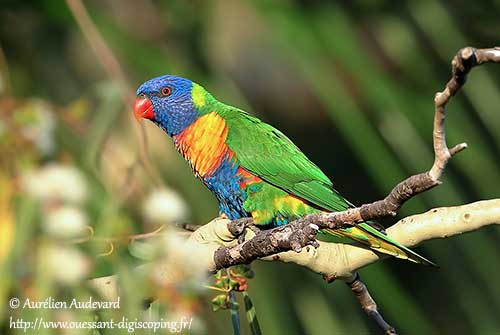
CALLS AND SONGS: SOUNDS BY XENO-CANTO
The Rainbow Lorikeet gives sharp, rolling screech, regularly repeated when in flight. When feeding, it utters shrill chattering. When at rest, the birds regularly utter a soft twittering.
BEHAVIOUR IN THE WILD:
The Rainbow Lorikeets gather in small groups of 5 to 20 birds when feeding. They are very noisy. They feed among foliage, taking fruits, insects, pollen and nectar.
This species has a particular tongue which tip is covered with tiny papillae. It uses it for sweeping up the pollen grain while feeding on flowers. If the food resources are abundant, some flocks may contain hundreds of birds. They fly above the treetops while screeching loudly.
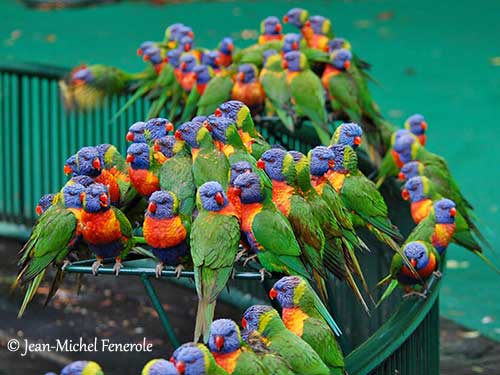
They may damage the orchards and the species is classified as a pest in some regions. They are very active in the early morning and in the late afternoon. They rest in shade in treetops in the middle of the day.
They sleep in communal roosts in large numbers. They are very noisy before establishing their positions in the roosting trees. However, they also roost and nest on the ground in some predator-free islands.
During the breeding season, the male performs courtship displays. It approaches the female with stretched attitude. Then, it bows the neck and bobs its head while hopping along the perch and uttering a low whistle. During these displays, its pupils dilate and contract continuously. The female will be interested if she is ready to nesting. The pairs stay together for life. They are monogamous.
The Rainbow Lorikeets are very gregarious and mainly arboreal. They are usually seen in pairs or flocks, even mixed flocks. It comes down to the ground for drinking.
The Rainbow Lorikeet moves and disperses for food as it depends on flowering trees. They can be seen out at sea, in transit between islands.
The flight is swift and direct. We can hear a whirring sound coming from the rapid, shallow wing beats. They fly very high over long distances. During shorter flights, they often twist and turn through the treetops.
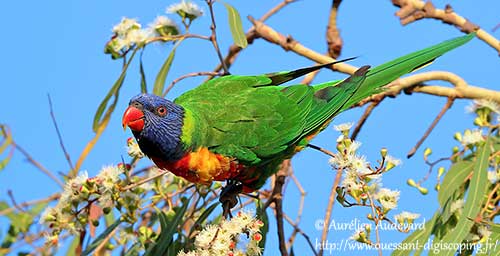
REPRODUCTION OF THIS SPECIES:
The breeding season occurs mainly from August to January in SE Australia, and almost year-round in Queensland.
The Rainbow Lorikeet nests in hollow in tree trunk or limb, sometimes in buildings. The nest is relatively high, between 3 and 30 metres above the ground. It is made by both adults. The hole is usually unlined, but wood chips and dry grasses can be added sometimes.
In the wild, the female lays two white eggs. The incubation lasts about 22 to 25 days, by the female alone. During this period, the male spends most of time at nest with its mate, and it may feed her.
The altricial chicks are fed by both parents. The young fledge at about 54 to 57 days of age. They become independent about 2-3 weeks later and then, the young birds join the communal roost.
The main predator of this species is the Powerful Owl (Ninox strenua).
PROTECTION / THREATS / STATUS:
The Rainbow Lorikeet is considered a pest in S Australia, because it damages fruit trees, and can destroy large part of fruit crops when it feeds on them.
It is widespread and usually common in Australia. However, the international pet-trade remains a threat for this beautiful bird because it is very appreciated as a pet with a fun natural temperament.
The size of the population is unknown but it is suspected to be decreasing.
But the Rainbow Lorikeet is not still globally threatened and currently evaluated as Least Concern.
